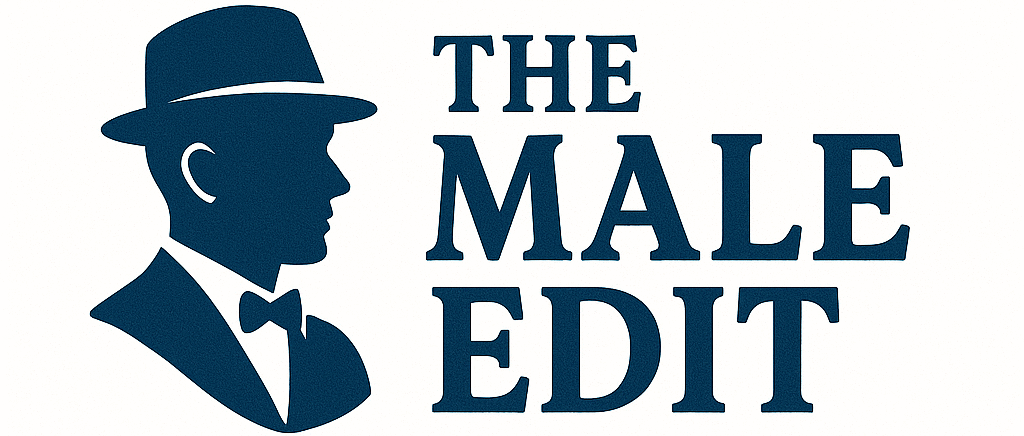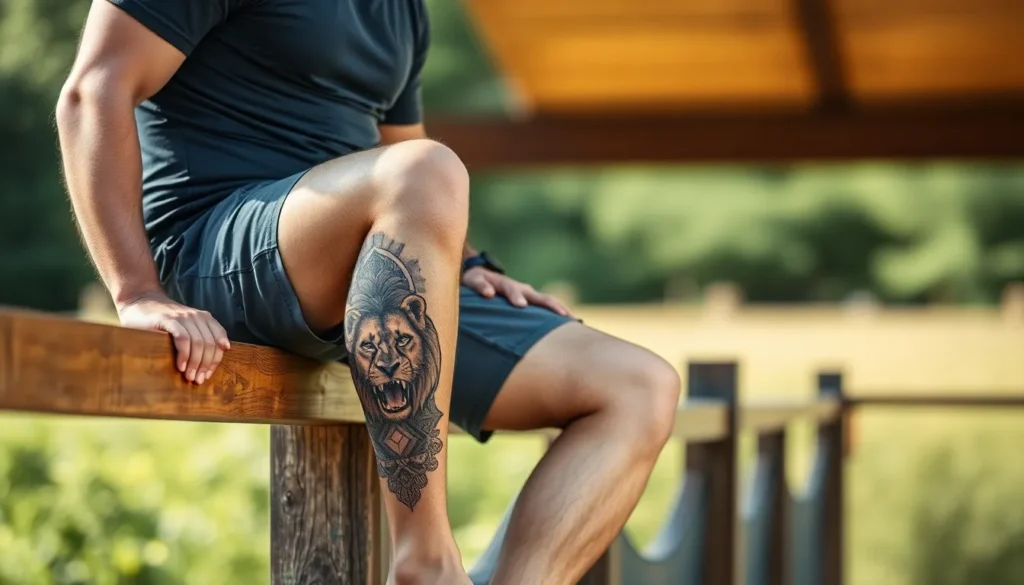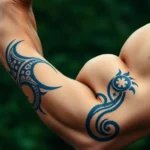Leg tattoos have become one of the most popular choices for men looking to make a bold statement with their ink. Whether you’re considering your first tattoo or adding to an existing collection, the leg offers an incredible canvas that’s both versatile and visually striking.
We’ve seen a massive surge in men choosing leg tattoos over the past few years, and it’s easy to understand why. The leg provides ample space for everything from intricate sleeve designs that wrap around your calf to powerful standalone pieces on your thigh. Plus, you’ll have complete control over visibility – perfect for professional settings or when you want to show off your artwork.
From traditional tribal patterns to modern geometric designs, realistic portraits to abstract art, leg tattoos offer endless possibilities. We’re here to guide you through the most popular styles, placement options, and design ideas that’ll help you create the perfect leg tattoo that matches your personality and lifestyle.
Traditional Leg Tattoo Designs That Never Go Out of Style
Traditional tattoo designs have stood the test of time because they represent timeless values and universal symbols that resonate across generations.
Classic Anchor and Nautical Themes
Anchor tattoos symbolize stability and strength while maintaining their position as one of the most requested traditional designs for men’s legs. Sailors originally chose these maritime symbols to represent their connection to the sea and their hope for safe returns home. We often see anchor designs paired with rope details, compass roses, or ship wheels to create comprehensive nautical compositions.
Sailing ship tattoos work exceptionally well on the calf area where the curved muscle provides natural dimension to the vessel’s hull. These designs typically feature bold black outlines with minimal color fills following traditional American tattoo style guidelines. Popular variations include pirate ships, naval vessels, and vintage clipper ships that span from ankle to knee.
Lighthouse designs offer vertical composition opportunities that complement the leg’s natural lines. These tattoos often incorporate crashing waves at the base and stormy skies above to create dramatic contrast. Many men choose to add personal elements like dates or coordinates of meaningful coastal locations.
Tribal Patterns and Celtic Knots
Polynesian tribal designs create bold geometric patterns that wrap around the leg’s contours with striking visual impact. These traditional tattoos tell stories through exact symbols like turtles for longevity, sharks for protection, and waves for life’s journey. We recommend working with artists experienced in Polynesian tattooing to ensure cultural accuracy and proper symbol placement.
Celtic knotwork features intricate interwoven patterns that represent eternal connections and spiritual journeys. These designs work particularly well as bands around the thigh or calf where the circular patterns can flow naturally. Common variations include trinity knots, Celtic crosses, and endless knot patterns that can extend vertically along the entire leg.
Maori inspired tattoos incorporate traditional Ta Moko elements adapted for modern application while respecting cultural significance. These designs often feature spirals, curves, and geometric shapes that follow the leg’s muscle definition. Many men choose to combine multiple Maori symbols to create personalized narratives about their life experiences.
Religious Symbols and Cross Designs
Traditional crosses remain among the most popular religious tattoo choices for men’s legs due to their vertical orientation and symbolic power. Gothic crosses feature ornate details and architectural elements while simple Latin crosses emphasize clean lines and spiritual meaning. We often see these designs enhanced with banners containing scripture verses or meaningful dates.
Angel imagery creates powerful religious statements when rendered in traditional tattoo style with bold outlines and classic shading techniques. Guardian angels work well on the thigh area where larger compositions have adequate space for detailed wing work and facial features. Many men incorporate angel designs with other religious elements like halos, clouds, or divine light rays.
Scripture and religious text tattoos offer deeply personal expressions of faith when integrated with traditional design elements. Popular placements include wrapping text around existing religious imagery or creating standalone text pieces along the shin or thigh. We recommend choosing fonts that maintain readability over time and complement the overall traditional aesthetic.
Modern Geometric Leg Tattoos for the Contemporary Man
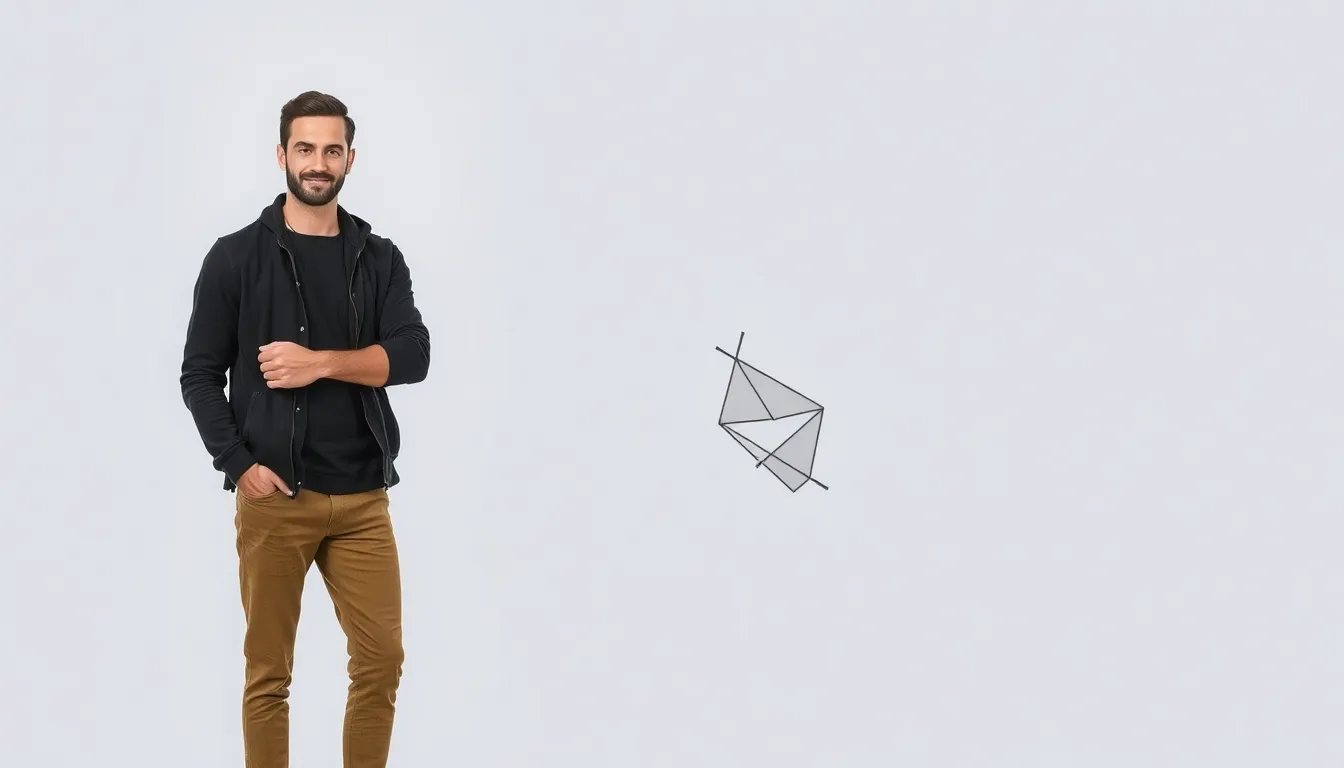
Contemporary men are increasingly drawn to geometric leg tattoos that emphasize precision, balance, and mathematical beauty. These designs represent a sophisticated evolution from traditional tattooing, incorporating clean lines and structured patterns that create visually striking compositions on any part of the leg.
Minimalist Line Work and Shapes
Minimalist geometric tattoos employ simple line work and basic shapes such as squares, triangles, and dots that create powerful visual impact through restraint. These designs emphasize negative space and clean execution, reflecting a refined aesthetic that fits particularly well on calves, ankles, or the lower leg. We see many men choosing single triangles, intersecting circles, or parallel lines that maintain elegance without overwhelming the natural contours of the leg. Simple dot work patterns create texture and depth while maintaining the minimalist philosophy that less is more.
Sacred Geometry and Mandala Patterns
Sacred geometry features patterns like the Flower of Life or Metatron’s Cube that carry spiritual and philosophical meanings related to unity, balance, and the universe. These compelling designs make meaningful choices for leg tattoos because they combine visual complexity with deeper symbolism. Mandala inspired patterns work exceptionally well on the thigh or calf, where the circular designs can fully expand and showcase their intricate details. We often recommend these patterns for men seeking tattoos that represent harmony, inner strength, and connection to universal principles.
Abstract Geometric Compositions
Abstract arrangements of geometric forms create unique, artistic tattoos that focus on harmony and contrast rather than recognizable shapes. These designs can be bold or understated and often represent the wearer’s personal interpretation of order and chaos. Complex arrangements might combine triangles, circles, and intersecting lines to form compositions that evoke balance and precision. We’ve observed that these abstract pieces work particularly well as full leg sleeves, where multiple geometric elements can interact and create flowing visual narratives from ankle to thigh.
Wildlife and Nature-Inspired Leg Tattoo Ideas
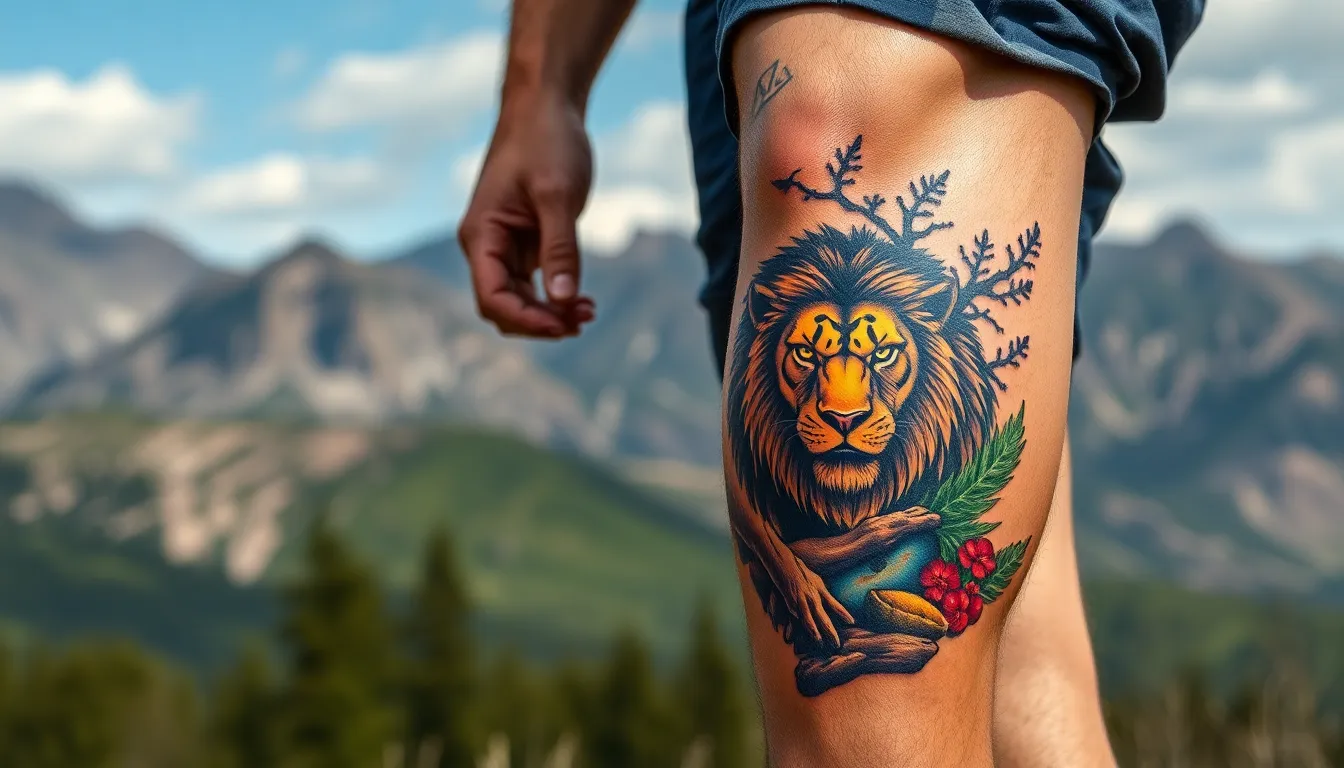
Nature provides endless inspiration for powerful leg tattoos that connect us to the wild industry around us. These designs combine striking visual appeal with deep symbolic meanings that resonate with men seeking meaningful body art.
Fierce Animal Portraits and Predators
Lions dominate the industry of animal tattoos with their representation of strength and leadership. We see these “king of the jungle” designs frequently chosen for their commanding presence on the leg’s expansive canvas. Bears showcase power and endurance through their ability to thrive in harsh conditions, making them perfect symbols of resilience for men facing life’s challenges.
Wolves offer versatile meaning as they can represent both the lone survivor and the loyal pack member. These creatures embody survival skills and adaptability, appealing to men who value independence or brotherhood. Owls stand for wisdom and nocturnal spirit, making them ideal choices for men who identify with insightfulness or prefer the quiet hours of night.
Tigers and eagles round out the most popular fierce animal choices, often rendered in realistic detail or striking black forest style across leg sleeves. These predators create powerful visual statements that command respect and attention.
Forest Scenes and Mountain Landscapes
Dense forest tattoos and mountain ranges create immersive scenes that evoke deep connections to nature and exploration. We often see these designs incorporating towering trees, hidden wildlife like wolves or owls, and rugged terrains that transform the leg into a scenic sleeve masterpiece.
Jungle themed leg sleeves blend wild flora and fauna into cohesive designs celebrating natural habitats. These complex compositions allow artists to showcase intricate details across the leg’s generous surface area. Mountain landscapes provide dramatic backdrops for wildlife portraits, creating layered storytelling through ink.
Forest scenes work particularly well when they flow from thigh to calf, using the leg’s natural contours to enhance the illusion of depth and movement through wilderness terrain.
Ocean Life and Marine Creatures
Marine inspired leg tattoos celebrate the mysterious and powerful nature of our oceans through striking aquatic imagery. Whales, sharks, and octopuses serve as popular centerpieces for these designs, each bringing unique symbolic weight to the composition.
Coral patterns and wave motifs add flowing elements that complement the leg’s natural lines and movement. These oceanic creatures reflect personal connections to the sea while symbolizing fluidity, adaptability, and raw strength found beneath the waves.
Ocean themed tattoos often incorporate deep blues and flowing designs that create movement even when still, making them particularly effective on the calf where muscle definition can enhance the illusion of swimming creatures or rolling waves.
Full Leg Sleeve Tattoos for Maximum Impact
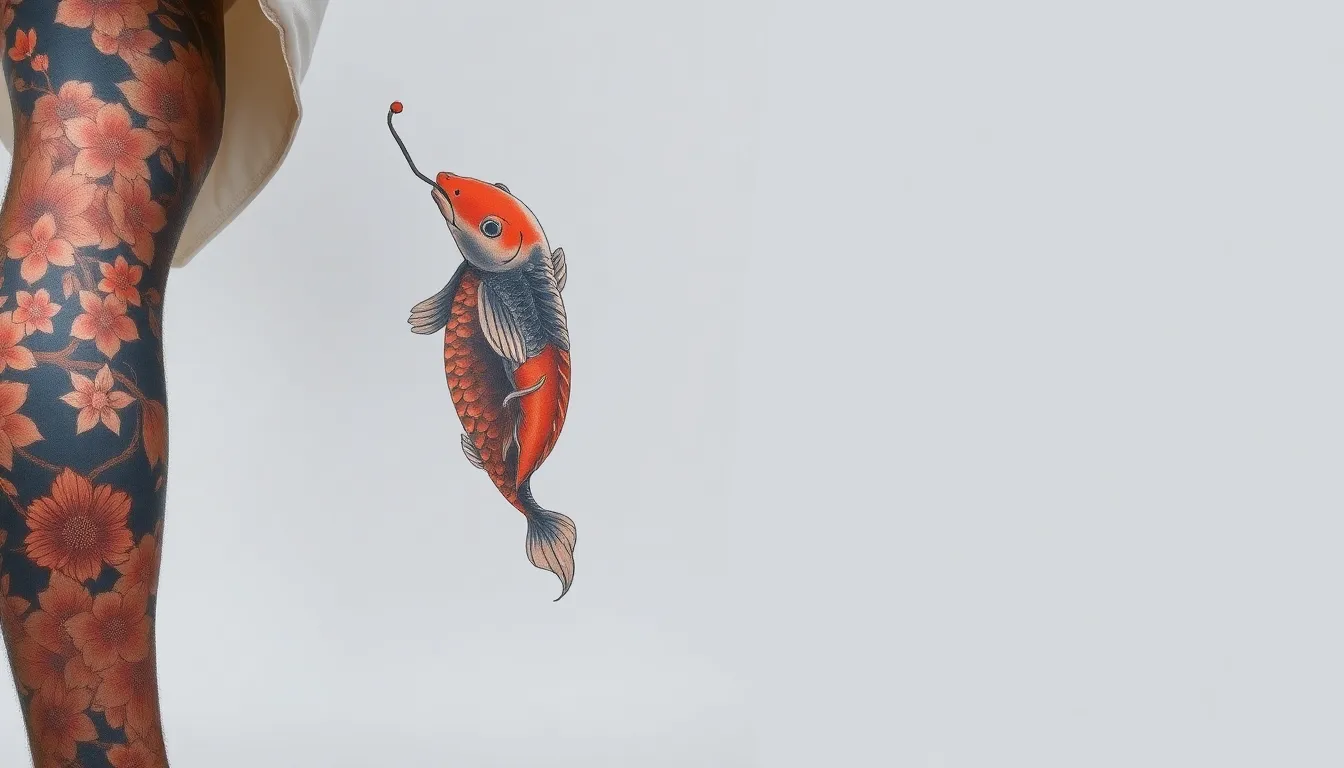
Full leg sleeve tattoos represent the ultimate commitment to leg artistry, transforming your entire leg from thigh to ankle into a comprehensive masterpiece. These extensive designs offer the largest possible canvas for complex storytelling and detailed artwork that wraps seamlessly around the leg’s natural anatomy.
Japanese-Style Leg Sleeves
Traditional Japanese motifs create some of the most visually striking leg sleeves available to modern tattoo enthusiasts. Koi fish, dragons, samurai warriors, and cherry blossom patterns flow naturally with the leg’s curves, creating ever-changing compositions that move with your body. These designs feature vibrant colors and bold outlines that maintain their visual impact across the leg’s varying surfaces.
Symbolic storytelling reaches its peak in Japanese leg sleeves, where each element carries cultural significance and personal meaning. Dragons represent strength and wisdom, while koi fish symbolize perseverance and transformation. Cherry blossoms add delicate beauty to contrast with more powerful imagery, creating balanced compositions that honor traditional Japanese artistry.
Biomechanical and Cyborg Designs
Mechanical elements fused with human anatomy create futuristic leg sleeves that transform your natural musculature into cyborg-like artworks. Exposed robotic parts, gears, and mechanical joints appear to emerge from beneath the skin, requiring meticulous detail and expert shading to achieve realistic 3D effects. These designs appeal particularly to men fascinated by science fiction and technological themes.
Anatomical accuracy becomes crucial in biomechanical leg sleeves, as artists must understand muscle structure to create convincing illusions of mechanical integration. Pistons, cables, and metallic plating follow the leg’s natural contours, improving rather than fighting against your body’s existing form. The result creates an impressive cyborg aesthetic that appears both organic and mechanical.
Photorealistic Portrait Galleries
Lifelike portraits and detailed scenes transform leg sleeves into living galleries that showcase incredible artistic skill and technical precision. Large leg surfaces accommodate stunning portraiture of loved ones, historical figures, or favorite celebrities with maximum detail and visual impact. These tattoos demand exceptional artistry to capture subtle facial expressions and realistic skin tones.
Three-dimensional nature scenes also thrive in photorealistic leg sleeves, depicting everything from dramatic landscapes to intimate wildlife encounters. Artists use the leg’s smooth, flat surfaces to create immersive environments that appear to extend beyond the skin’s boundaries. Each piece requires multiple sessions and careful planning to achieve the photographic quality that defines this demanding style.
Small and Subtle Leg Tattoo Options
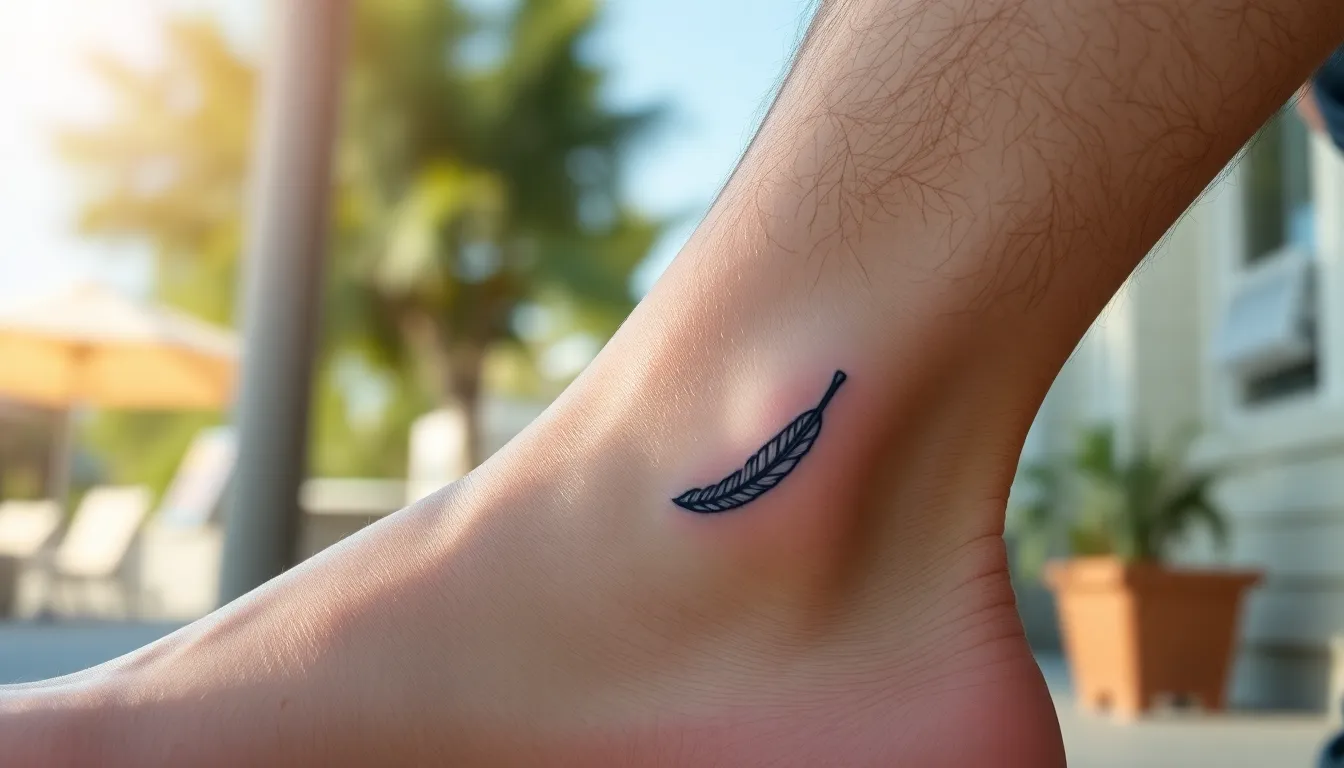
Moving beyond bold, comprehensive designs, we’re exploring refined options that make a sophisticated statement. These understated pieces offer maximum versatility while maintaining personal significance.
Ankle Tattoos and Delicate Designs
Ankle tattoos create elegant focal points that showcase refined artistic sensibilities. These delicate designs feature fine line work, small animals, minimalist symbols, or geometric patterns that perfectly complement the ankle’s natural contours. We love how these subtle pieces remain hidden during professional settings yet reveal themselves beautifully with shorts or when barefoot.
Small geometric shapes like triangles, circles, or arrows work exceptionally well in this location. Nature inspired elements such as tiny leaves, feathers, or celestial symbols create meaningful connections without overwhelming the space. The ankle’s compact canvas demands precision, making these tattoos ideal for men who appreciate detailed craftsmanship in smaller formats.
Calf Muscle Accent Pieces
Calf muscle tattoos use the leg’s natural vertical canvas to create striking accent pieces. This elongated space accommodates medium to large designs that can highlight muscular definition while offering excellent visibility control. Tribal patterns with bold lines flow naturally with the calf’s curves, creating ever-changing visual movement.
Nature inspired imagery like trees, mountain silhouettes, or wildlife portraits work beautifully on this muscular canvas. Geometric abstract art can transform the calf into a living sculpture, with patterns that emphasize the leg’s natural athleticism. We find that calf tattoos offer the perfect balance between visibility and concealment, appearing prominently in shorts while remaining hidden in pants.
Behind-the-Knee Hidden Gems
Behind the knee tattoos serve as personal hidden gems that reveal themselves only in exact positions or movements. This intimate location requires smaller, more discreet designs due to the skin’s natural movement and sensitivity. Symbolic artwork, meaningful dates, or artistic elements create personal significance in this secretive spot.
These hidden pieces often feature simple line work, small symbols, or delicate patterns that work with the skin’s natural flexion. We appreciate how behind the knee tattoos offer complete privacy, becoming visible only when legs are bent or during intimate moments. This placement appeals to men seeking deeply personal artwork that remains truly private until deliberately revealed.
Sports and Hobby-Themed Leg Tattoos
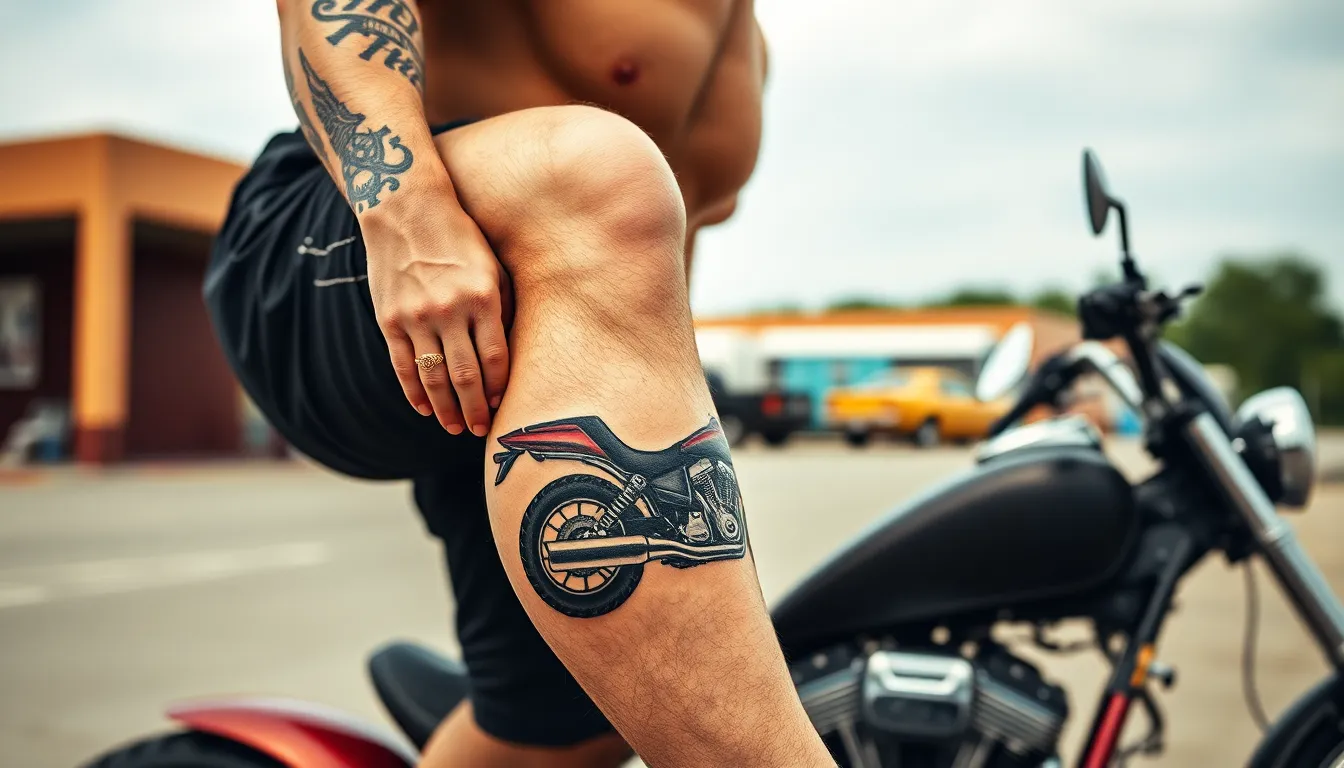
When we combine personal passions with body art, sports and hobby-themed leg tattoos become powerful expressions of identity and lifestyle.
Athletic Symbols and Team Logos
Team loyalty runs deep in sports enthusiasts, making athletic symbols and team logos some of the most popular choices for leg tattoos. Football helmets, basketballs, and runners create ever-changing designs that showcase athletic passion and personal achievements. We see these bold displays particularly effective on the calf and thigh areas, where ample space allows for clear, detailed representations of favorite teams and sports.
Mascots and team emblems work exceptionally well on muscular legs, creating striking visual statements that celebrate athletic identity. The calf’s natural curves enhance the ever-changing feel of sports imagery, while the thigh provides enough canvas for elaborate team-themed storytelling tattoos. Professional athletes and weekend warriors alike choose these designs to honor their dedication to exact sports or commemorate important achievements in their athletic journey.
Musical Instruments and Notes
Musicians and music lovers find meaningful expression through tattoos featuring guitars, drums, microphones, and musical notation. These artistic elements typically occupy the calf or thigh area, incorporating creative flourishes that demonstrate the wearer’s deep connection to music. We recommend these designs for both professional musicians and passionate hobbyists who want to showcase their musical identity.
Lyrical excerpts from favorite songs often accompany instrument designs, creating personalized compositions that tell musical stories. Musical notes can flow elegantly along the leg’s natural lines, while larger instruments like guitars or drum sets make bold statements on the thigh. The vertical space of the shin also accommodates narrow musical elements like microphone stands or elegant treble clefs.
Automotive and Motorcycle Designs
Speed enthusiasts frequently select automotive and motorcycle designs that symbolize freedom, power, and mechanical passion. Cars, motorcycles, engines, and mechanical parts create ever-changing artwork that celebrates the automotive lifestyle. These designs particularly suit the shin or calf areas, where vertical and elongated compositions enhance the sense of movement and mechanical precision.
Classic muscle cars, vintage motorcycles, and detailed engine components work beautifully as leg tattoos, especially for those with active lifestyles who appreciate mechanical artistry. We find that automotive tattoos often incorporate flames, racing stripes, or gear elements that complement the leg’s natural contours. The calf’s visibility makes it perfect for showing off intricate motorcycle designs, while the thigh accommodates larger automotive scenes that tell complete mechanical stories.
Placement Considerations for Men’s Leg Tattoos
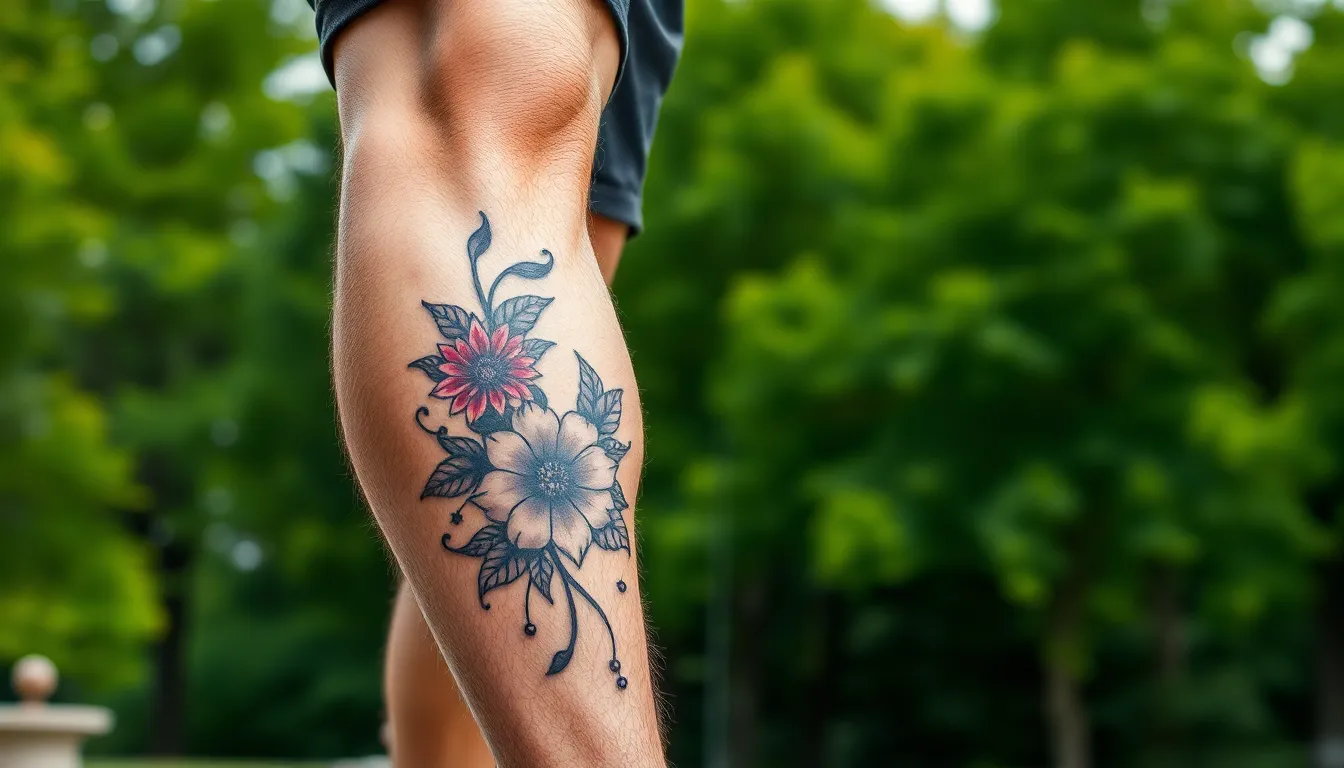
Choosing the right placement for your leg tattoo significantly impacts both the visual appeal and practicality of your design. Different areas of the leg offer unique advantages based on pain tolerance, visibility preferences, and the type of artwork you want to showcase.
Front Thigh vs. Back Thigh Positioning
Front thigh placement offers the most popular choice for men seeking maximum visibility and design flexibility. This area provides ample flat space that’s perfect for detailed portrait tattoos or elongated designs like floral motifs and snake patterns that can elegantly wrap around the hip area. We find this location easier to display when desired and simple to conceal with clothing when needed.
Back thigh positioning creates a more private and visually striking alternative that’s less commonly chosen. Designs in this area can wrap around the entire leg for a more immersive effect, though the pain level tends to be higher due to increased nerve density. Inner thigh areas particularly rank higher on the discomfort scale, making this placement better suited for those with higher pain tolerance.
Calf Muscle Tattoo Advantages
Calf tattoos benefit from the natural muscular contour that enhances any design’s visual impact dramatically. This area suits circular and wrap-around designs exceptionally well, allowing artwork to creatively follow the calf’s natural shape and movement.
Versatility makes calf placement highly favored among men, accommodating everything from small minimalist symbols to larger detailed pieces. We can easily show off calf tattoos with shorts or conceal them with pants, making them ideal for professional environments. The calf’s muscle definition naturally emphasizes the tattoo’s lines and shading, creating a more ever-changing appearance.
Shin and Ankle Placement Tips
Shin tattoos create bold, highly visible statements that can’t be easily hidden. This bony area increases discomfort during the tattooing process, but the prominent placement makes designs stand out dramatically. We recommend choosing simpler designs for shin placement since the area’s shape can distort intricate details.
Ankle tattoos work best for small, simple designs like symbols, scripts, or minimalist artwork due to the limited space available. This area experiences more wear and tear from shoes and movement, causing tattoos to fade faster than other leg locations. Pain levels rank higher here because of the thin skin and bones positioned close to the surface, making sessions more challenging but resulting in unique, eye-catching placement that’s perfect for personal expression.
Pain Levels and What to Expect During the Process
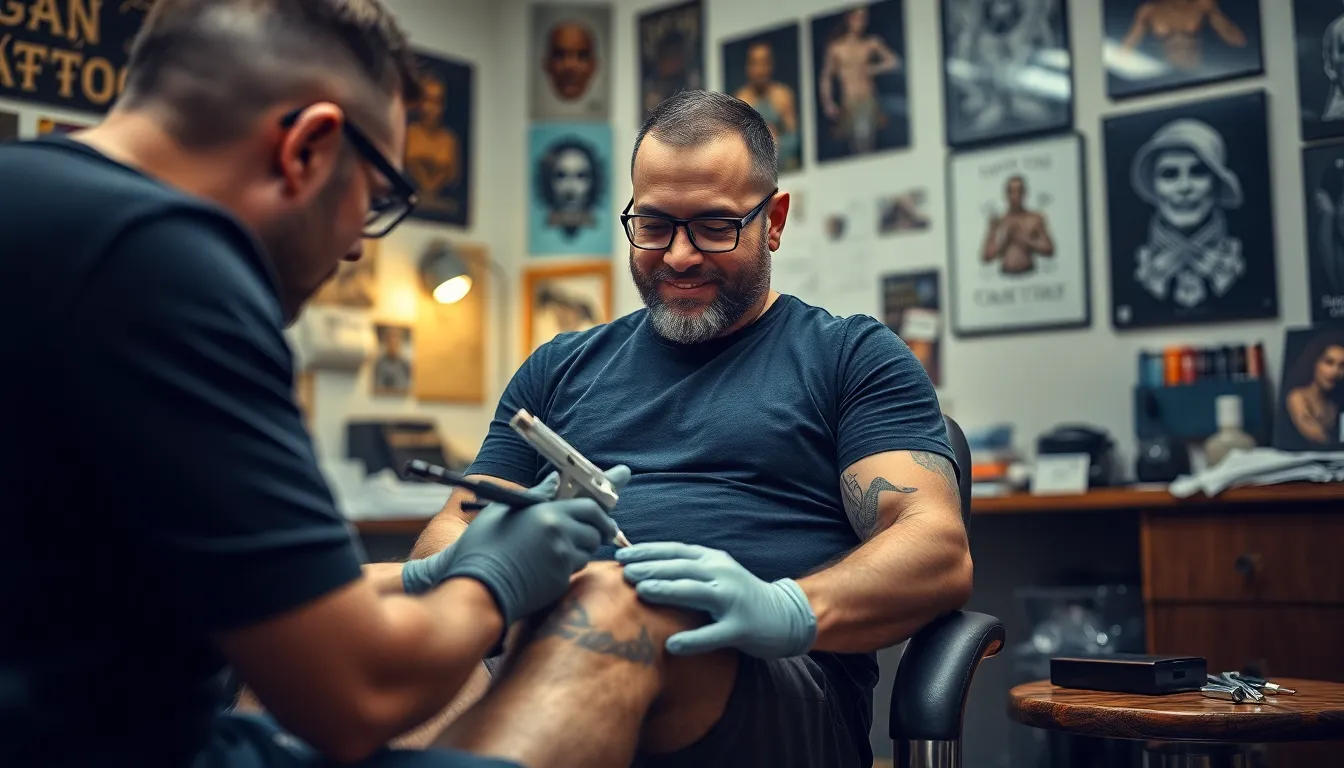
Understanding pain levels helps you prepare mentally and physically for your leg tattoo journey. We’ll explore the varying sensations you can expect and how different factors influence your comfort during the process.
Most Painful Leg Tattoo Locations
Knee and knee ditch areas rank as the most excruciating spots on your leg, earning a perfect 10/10 on the pain scale. The sciatic nerve runs directly behind your knee while extremely thin skin offers minimal protection from the needle’s impact. Healing becomes particularly challenging due to constant movement and fabric rubbing against the fresh tattoo.
Shin tattoos deliver intense sharp sensations that rate around 9/10 for pain intensity. Your skin sits directly over the bone with many nerve endings concentrated in this area. Every needle strike feels amplified as there’s virtually no fat padding to cushion the impact.
Back of the calf near the knee produces important discomfort due to nerve concentration and bone proximity. This area combines the worst aspects of both knee and calf tattooing. Movement during daily activities can intensify the pain even after your session ends.
Ankle and foot regions create bone-on-bone sensations that register at 9/10 on most pain scales. The minimal flesh coverage means every needle penetration hits close to solid bone. Swelling often occurs more readily in these areas due to gravity and circulation patterns.
Least Painful Areas for Beginners
Upper outer thigh provides the most comfortable tattooing experience with pain levels around 2/10. Ample fat padding and fewer nerve endings make this location ideal for your first leg tattoo. The generous surface area also allows for larger designs without moving to more sensitive zones.
Outer leg sections including mid-calf and outer thigh areas offer mild discomfort levels perfect for beginners. More muscle and fat cushioning create a buffer between the needle and your bones. These locations heal faster due to better blood circulation and less daily friction.
Outer calf areas away from the knee provide moderately low pain suitable for those with lower pain tolerance. The natural curve of your calf muscle helps distribute the tattooing pressure more evenly. Artists often recommend starting here to gauge your personal pain threshold before moving to more sensitive areas.
Pain Management Techniques
Selecting less painful locations like the outer thigh or outer calf significantly reduces your overall discomfort. We recommend starting with these areas if you’re new to tattooing or have concerns about pain tolerance. Your artist can help map out designs that use the most comfortable zones on your leg.
Communicating openly with your tattoo artist allows them to adjust their technique and pressure throughout the session. Skilled professionals modify their approach based on your feedback and visible reactions. They’ll often work in sections to give particularly sensitive areas time to recover.
Taking regular breaks during long sessions prevents pain fatigue and maintains your comfort levels. Most artists schedule 15-minute breaks every hour for larger pieces. These pauses allow your endorphins to reset and give you mental preparation for continuing.
Using numbing creams or sprays can reduce initial pain sensations when applied properly before your appointment. Some tattoo studios offer topical anesthetics as part of their service. Always discuss these options with your artist beforehand as some products can affect ink absorption.
Staying hydrated and well-rested before your session decreases your pain sensitivity significantly. Fatigue and dehydration amplify every sensation your body experiences. We suggest getting a full night’s sleep and drinking plenty of water in the 24 hours before your appointment.
Employing distraction techniques like listening to music or practicing breathing exercises helps manage pain mentally. Many clients find that focusing on something other than the tattooing process reduces their perceived discomfort. Deep breathing exercises specifically help activate your body’s natural pain-relieving responses.
Aftercare Tips for Healing Leg Tattoos
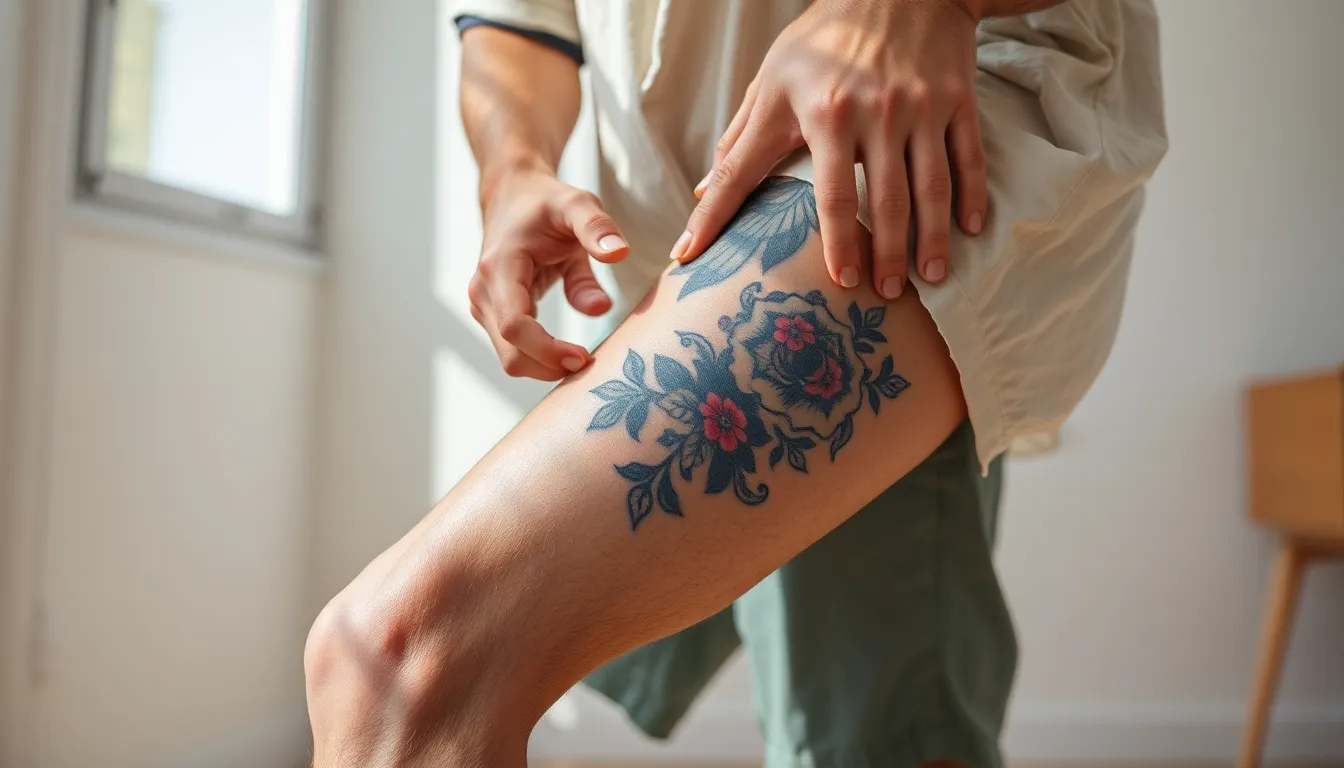
Proper aftercare ensures your new leg tattoo heals correctly and maintains its vibrant appearance for years to come. Following exact care guidelines during the initial healing period prevents infection and promotes optimal results.
Proper Cleaning and Moisturizing
Clean your fresh leg tattoo 2 to 3 times daily using mild antibacterial soap or plain bath soap to remove bacteria and debris. Avoid harsh substances like hydrogen peroxide or rubbing alcohol since they damage healing skin and slow recovery.
Gently pat the tattooed area dry with a clean towel rather than rubbing to prevent irritation. Apply a thin layer of antibiotic ointment or tattoo exact aftercare product during the first five days of healing.
Switch to fragrance free, dye free water based moisturizers after the initial healing phase to keep skin hydrated without clogging pores. Products containing petrolatum should be avoided if your tattoo artist recommends against them since they trap dirt and increase infection risk.
Continue moisturizing throughout the healing process and beyond to maintain healthy skin and preserve ink quality. Consistent hydration helps prevent scabbing and ensures proper color retention.
Clothing Choices During Recovery
Wear loose, breathable clothing around your tattooed leg to minimize friction and irritation on fresh ink. Tight pants or restrictive fabrics can rub against the healing tattoo and disrupt the recovery process.
Choose natural fabrics like cotton that allow proper airflow and reduce sweat buildup around the tattoo site. Synthetic materials often trap moisture and create breeding grounds for bacteria.
Avoid clothing that directly contacts the tattoo during the first few days of healing. Consider wearing longer shorts or rolled up pants that don’t touch the tattooed area.
Activity Restrictions and Exercise Guidelines
Minimize physical activities that cause excessive leg movement or sweating during the initial healing period. Heavy workouts can slow healing and increase infection risk through excessive moisture and movement.
Avoid swimming, hot tubs, and soaking your tattoo for at least 2 to 3 weeks to prevent bacterial exposure from contaminated water. Submersion can also cause ink to leach out and fade prematurely.
Limit exercises that stretch or put direct pressure on the tattooed area until healing completes. Listen to your body and stop activities that cause pain or excessive irritation around the tattoo.
Remember that blood flow to lower leg areas moves slower than other body parts, which means healing takes longer and requires extra attention. Monitor your tattoo closely for signs of infection like increasing redness, swelling, pus, or excessive pain, and consult a healthcare provider if these symptoms appear.
Conclusion
We’ve covered everything you need to know about leg tattoos for men – from timeless traditional designs to cutting-edge geometric patterns and everything in between. Your legs offer an incredible canvas for self-expression whether you’re drawn to bold full sleeves or subtle ankle pieces.
Remember that choosing the right placement is just as important as selecting your design. Consider your lifestyle pain tolerance and how visible you want your tattoo to be in different situations.
Take time to research experienced artists who specialize in the style you want. Quality work requires patience and investment but the results will speak for themselves for years to come.
Your leg tattoo journey is eventually about creating something meaningful that represents who you are. Trust the process follow proper aftercare and you’ll have a piece of art you’ll be proud to wear.
Frequently Asked Questions
What makes leg tattoos popular among men?
Leg tattoos offer a large canvas for intricate designs with excellent visibility control. You can easily hide them in professional settings or show them off casually. The leg’s natural contours enhance various design styles, from traditional anchors to modern geometric patterns, making them versatile for personal expression.
What are the most popular traditional leg tattoo designs?
Traditional designs include nautical themes like anchors, ships, and lighthouses symbolizing stability and strength. Tribal patterns and Celtic knots are also timeless choices, offering cultural significance and bold visual impact. Religious symbols like crosses and angels remain popular for expressing personal faith.
Are geometric leg tattoos suitable for beginners?
Yes, geometric tattoos work well for beginners, especially minimalist designs on calves and ankles. These feature clean lines, simple shapes, and balanced patterns that create a refined aesthetic. Sacred geometry and mandala patterns are meaningful options representing unity and balance.
Which leg placement is best for first-time tattoo recipients?
The upper outer thigh is ideal for beginners as it’s one of the least painful locations. This area offers ample space for medium to large designs and can be easily concealed. The natural muscle padding provides more comfort during the tattooing process.
How painful are leg tattoos compared to other body parts?
Pain levels vary by location. The knee and shin are most painful due to thin skin and bone proximity. The upper thigh and calf muscle areas are more comfortable. Most people find leg tattoos manageable, especially when using pain management techniques like breaks and proper hydration.
What’s the difference between front and back thigh tattoos?
Front thigh tattoos offer better visibility and design flexibility, making them popular for showcasing artwork. Back thigh tattoos provide more privacy and discretion but typically involve higher pain levels. Both locations accommodate large, detailed designs and heal relatively well.
How long do leg tattoos take to heal?
Leg tattoos typically take 2-4 weeks to heal completely. The healing process involves keeping the area clean, moisturized, and protected. Avoid tight clothing, heavy workouts, and swimming during the initial healing phase. Proper aftercare ensures vibrant, long-lasting results.
Can I wear regular pants after getting a leg tattoo?
Avoid tight-fitting pants during the first few weeks of healing. Wear loose, breathable clothing made from soft fabrics to prevent irritation and rubbing. Cotton materials work best as they allow air circulation and won’t stick to the healing tattoo.
What are the best leg tattoo designs for athletes?
Athletic symbols, team logos, and sports equipment designs work well for athletes. Popular choices include football helmets on the thigh, basketball designs on the calf, and running-themed tattoos on the shin. These tattoos celebrate athletic passion and lifestyle.
Should I get a full leg sleeve or start smaller?
Start smaller if you’re new to tattoos or unsure about commitment. Small ankle or calf pieces allow you to experience the process and healing. Full leg sleeves require significant time, money, and pain tolerance but create stunning comprehensive artwork when completed.
